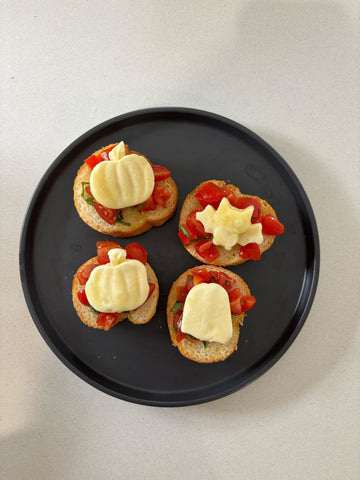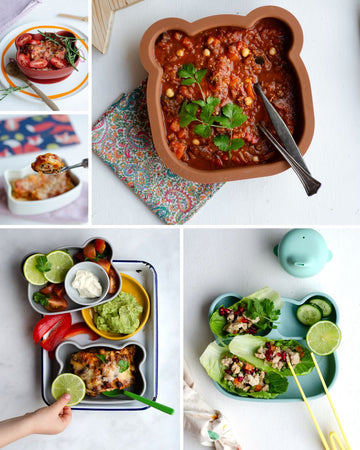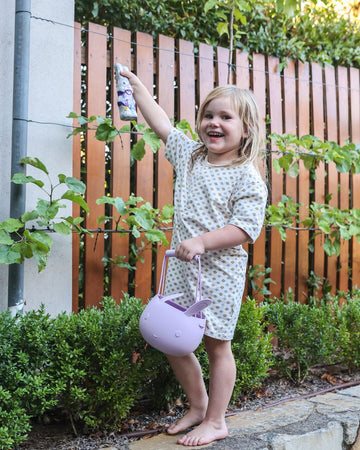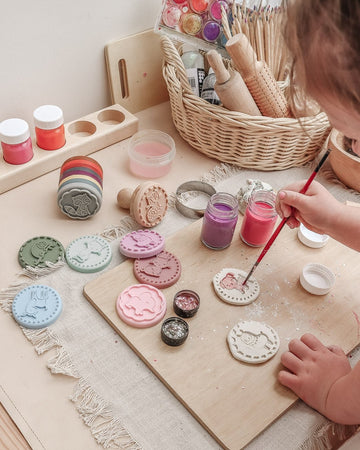Cutlery Tips for Babies and Toddlers
The Ultimate Guide to first positive experiences with spoon, fork and knife
Transitioning your baby to a confident self-feeding routine often comes with endless question marks and overwhelm.
Which cutlery set is right?
When do I introduce each utensil?
How can I support my baby along the way?
And is this all normal?
As big believers in fuss-free mealtime, we’re exploring all the BIG cutlery tips for babies and toddlers in the one place so you can actually enjoy the process as your little one grows their confidence with each self-feeding session.
Let’s dive right in.
What are the common cutlery milestones for babies and toddlers?
Between 6-9 months:
Your baby should start to show an interest in feeding themselves. It’s from this age onwards that they hold and mouth food, and love to grab a spoon to explore.
Between 9-13 months:
Your baby can feed themselves fingerfood of soft consistency or that melts quickly in their mouth.
By 14 months:
Your little one will start to dip a spoon into their food and direct it towards their mouth. This process usually is still rather messy and takes patience. They’re keen to explore what it feels like to spoon feed themselves.
By 24 months:
Your munchkin shows a growing interest to feed themselves and conquer mealtime independently.
Between 2-3 years:
This is when your little one will usually start to use a fork to stab their food.
By 5 years:
Your growing munchkin is ready to spread and cut their food with a knife. This is where it’s particularly important to equip them with age-appropriate toddler cutlery.
By 7 years:
Your child usually is able to use a knife and fork at the same time to cut and eat their food. Congrats, you now have a superstar self-feeder on your hands!
How can you support my baby or toddler to use cutlery?
- Make sure you sit your child in a well-supported position as they navigate this new skill. When first starting out, a high chair or your lap is the best spot for your munchkin to explore. Cushions also help straighten your little one in their high chair at a young age. For more experienced explorers, support their feet and back so their hands are free to roam. A table is the best environment to learn to eat with cutlery.
- Learning to self-feed takes time. And the best way to support your munchkin is by staying consistent and supportive as your child gradually grows their confidence.
- Invite your toddler to help set the table so they understand that cutlery is a routine part of every family meal. Their curiosity will spark great conversations along the way
- Once you start the process, don’t stop. Even if it seems far too messy at times. Practice makes perfect, so give your little one plenty of opportunities to explore
- Help your child by putting your hand over the top of your little one’s hand while they grasp the spoon
- Be the role model and simultaneously perform the actions so your munchkin can watch and learn from you
- Break the process down into easy-to-understand steps. The more time you take to explain what’s involved, the more likely they are to give it a go
- Some little ones prefer a mixture of cutlery and fingers to feed themselves. And that’s ok!
- Begin with pre-loading the spoon. This really helps in the early days by taking the pressure off while your munchkin is still working out the whole process.
In which order do I introduce spoon, fork and knife?
Before we explore the order to introduce your utensils, let’s begin with consistency. Always sweating out the dishes and age-appropriate cutlery in the same way will give your munchkin a sense of routine and grow their confidence with each meal.
Introducing cutlery into your self-feeding adventures usually is a 3-stage process.
You start with a spoon, followed by a combination of spoon and form, and then fork and knife. First, you introduce a spoon, then a spoon and fork, then your little one graduates to a fork and knife.
It’s usually around 10-14 months as your baby is ready to explore lumpier food textures and has a level of confidence when it comes to independent feeding that you introduce the fork and spoon combination.
What’s the right cutlery grasp for babies and toddlers?
Incorrect habits are hard to break, so stay consistent with the right cutlery grasp from the very first time you explore.
Get your little one to point their index finger down the back of the fork or knife facing the prongs or blade.
What to look out for when buying a cutlery set for your baby or toddler:
Your mealtime success often comes down to age-appropriate cutlery.
Easy-to-grab spoons and forks with thick, textured handles are much easier to hold than flimsy equivalents. At the same time, spoons and forks with short handles make it easier for your little one to guide the food to their mouth. And often, heavier utensils are easier to control.
As a general rule:
- Choose soft and gentle on baby gums
- Opt for plastic and BPA-free
- Go smaller and ergonomically designed
Mealtime accessories that can make it easier for your baby and toddler when to use cutlery:
Bowls or plates with a raised edge are proven to support your little one’s first self-feeding experience because they provide a raised surface to scoop against.
Non-slip materials such as silicone make this entire experience even more seamless. This can be in the shape of a non-slip placemat or a suction plate/bowl that stays put even when mealtime frustrations arise.
Things to consider when selecting food for cutlery practice sessions:
Good questions to ask yourself when planning your meals are:
Will it slide off the spoon or stick so it’s easy for my munchkin to eat?
Is the texture soft enough so munchkin can stab it with a fork or cut it with a knife?
Clever ways to practice cutlery use outside of mealtime:
The more practice you can sneak in, the quicker your little one will master this oh-so-important skill.
Craft activities that involve cutting and spreading motions, such as play dough or kinetic sand are perfect to grow their confidence without your munchkin even noticing. And why not throw a tea party with your favourite stuffed toys to encourage increased hand-eye coordination?
Ready to up your family’s self-feeding adventures?









